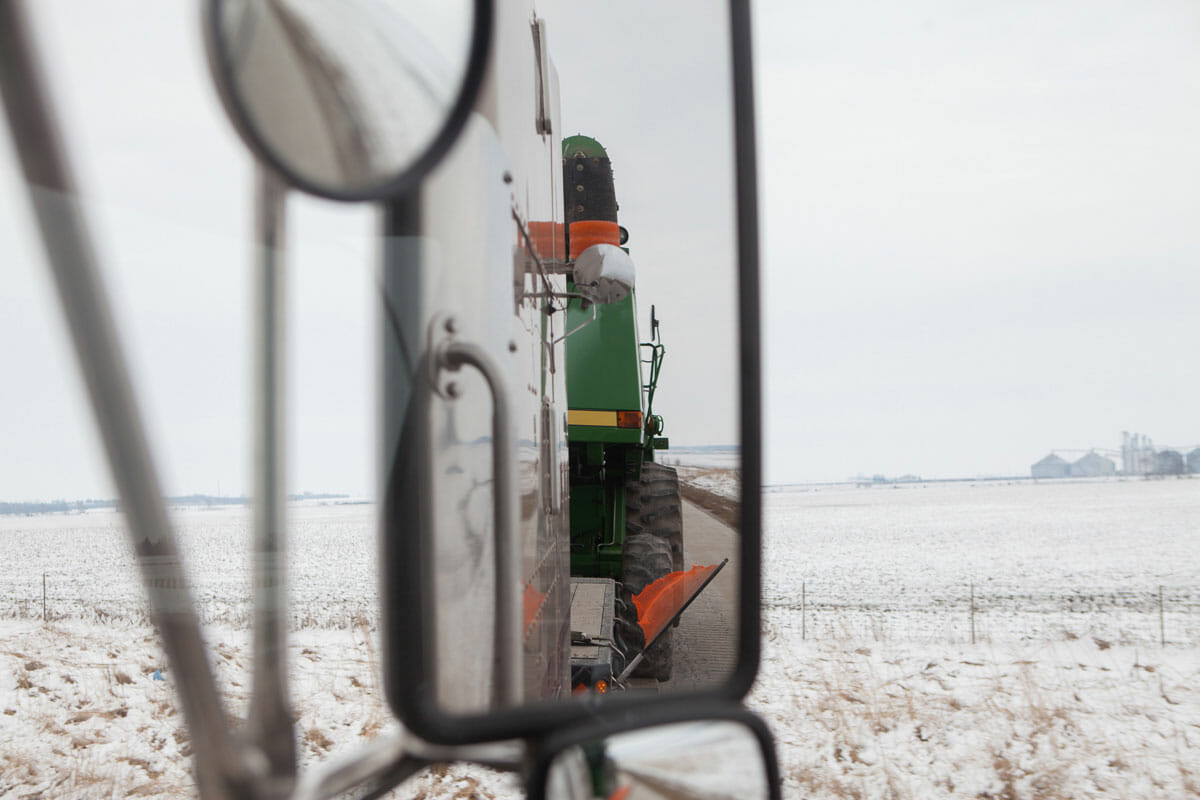What it's like taking a combine for a 500-mile-long delivery run.

This ’92 John Deere 9500 is bound for a family farm in Camlachie, Ontario, Canada, approximately 20 minutes from the Bluewater Bridge crossing in Port Huron, MI. Its new owner drove to New Holland, Illinois to personally inspect the combine himself before purchasing it and hiring a transport company to handle delivery. To everyone’s surprise at the implements shop, the combine starts up immediately despite sitting outside all winter.
[mf_1200px_image src=”https://modernfarmer.com/wp-content/uploads/2014/04/combine2.jpg” captionposition=”none” parallax=”off”]
The driver helps direct the combine as it’s carefully driven onto his drop-Âdeck trailer. It’s then up to the driver to make sure it stays there. Thick wooden blocks are placed under the frame near the combine’s front axle to stabilize it, and chains are used to secure it to the trailer. To ensure the combine is low enough to fit under overpasses, air must be released from the tires. Anything that could be potentially caught by wind on the road needs to be strapped down. For a vigilant operator, the entire process takes several hours to complete.
[mf_1200px_image src=”https://modernfarmer.com/wp-content/uploads/2014/04/combine3.jpg” captionposition=”none” parallax=”off”]
A load this large is classified as “oversize,” which introduces several unique regulations and precautions. While a vehicle escort isn’t required (the combine is neither wide nor long enough to warrant one), flags, signage and flashing beacons are necessary to warn other drivers. The driver must also secure a weight permit ahead of time approving the total tonnage of the load. Without it, truckers can face steep fines from weigh stations and Department of Transportation officials performing random inspections.
[mf_1200px_image src=”https://modernfarmer.com/wp-content/uploads/2014/04/combine4.jpg” captionposition=”none” parallax=”off”]
To prevent collisions, truck drivers hauling oversize loads can’t be on the road until 30 minutes before sunrise and must be off the road 30 minutes after it sets. Heavy snowfall also requires drivers to take a break, which, combined with short winter days, can make meeting delivery deadlines rather challenging. Still, the days are exhausting: truckers can be on the road for 11 hours in a given day, with an additional three hours allowed for maintenance and repairs. Downtime is scarce.
[mf_1200px_image src=”https://modernfarmer.com/wp-content/uploads/2014/04/combine5.jpg” captionposition=”none” parallax=”off”]
A little over 500 miles later, the driver reaches the farm and confers with the owner and his son about where to park. On his narrow road, backing into the driveway proves difficult.
[mf_1200px_image src=”https://modernfarmer.com/wp-content/uploads/2014/04/combine6.jpg” captionposition=”none” parallax=”off”]
Releasing the combine from its chains takes considerably shorter time than loading it. After pumping the tires back up, the combine is parked at its new home within the hour. The driver is done for the week, with two days of rest before hitting the road again.